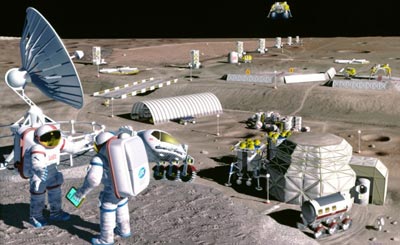This is how Dr. Peter Worden, head of NASA's Ames Research Center, describes the future, which will be opened by one single step of an astronaut on Mars, a step for which NASA is already preparing these days * Dr. Worden lectured as part of the Fisher Institute's annual space conference And the Ministry of Science that took place this week in Herzliya * The main part of his lecture: Mars - the next home of humanity

The US intends to return to the moon in 2020 and using the same technologies we can already carry out missions to asteroids that will last six months. Asteroids are interesting for additional reasons. Before landing on the moon there will be robotic missions and we hope to include Israel in these efforts, the technology here is excellent. So said Dr. Pete Worden, head of NASA's Ames Research Center and a world expert in both military and civilian space sciences. Dr. Worden lectured as part of the fourth annual Ilan Ramon Space Conference held this week at the Air Force Base in Herzliya.
The main part of Dr. Worden's lecture dealt with all the steps from today until the manned landing on Mars. "The first step to Mars is being taken these days by NASA in the development of the rockets that will take us beyond the orbit of the International Space Station to the Moon, a near-Earth asteroid and eventually - to a manned flight to Mars.
"Mars is our next destination and we will land astronauts on it in the first half of the century. Mars has a desert, which looks like the Negev and like places in the USA. But as we know, people can live in the desert. There is evidence that once there was water on Mars. In the photographs transmitted to us by the all-terrain vehicles patrolling on Mars, we see layers of rocks, evidence of the existence of water in the past. There is also ice on Mars, a significant amount of water even today and among other things we see in one of the pictures taken from space also a volcanic crater and a small glacier inside.

The Phoenix spacecraft that operated on Mars this year photographed snow falling on Mars. We saw from the data released by the Phoenix A block of ice in an excavation made using the lander's shovel, which in a later picture disappeared due to its evaporation as a result of exposure to the atmosphere. The most interesting part of Mars is under the ground there may be Flowing water, heat source maybe even volcanic activity. It's possible there might even be life there. Although, of course, these are micro-organisms. We also have evidence of active geology on Mars.
"Think of Mars as the future home of man and we are about to get there. These days we are developing new missiles at NASA: Ares 1 and Ares 5. Ares 1 will be launched for a test flight in about a year. These rockets will not only replace the shuttle with flights to the space station, but will also allow flights deep into space - to the moon and even to Mars, with different adjustments. When the Ares 5 development is completed in 6-8 years, it will be the largest rocket ever built, 150 tons for low earth orbit, it will make it possible to return to the moon to visit near-earth asteroids, and finally to reach Mars."
“Asteroids have become very interesting. In the general public they are treated as a potential threat. The dinosaurs were destroyed 65 million years ago by an asteroid, but there are asteroids that can provide many resources. Maybe even those made of platinum, but platinum is not the most important material in space, rather water is. Mars has many things we need - water, metals and organic and inorganic substances. Asteroids also have water and organic matter. The source of energy on Mars is solar radiation and underground geothermal energy. In asteroids, the energy comes only from the sun. Over the past few years we have discovered hundreds of thousands of new asteroids. When I was a student of astronomy, I knew that most of the asteroids are beyond the orbit of Mars, today we know that there are a hundred thousand of them close to the Earth and unfortunately some of them also hit the Earth. NASA developed tracking capabilities and other space agencies also contributed their part, so for example we see in the picture the asteroid Itakawa which the Yabusa spacecraft reached. It is a typical asteroid, half a kilometer in diameter.
On the moon itself we would like to establish an outpost near the poles, in areas that have not seen sunlight for millions of years and where there may be water in them. In the future we may travel to asteroids. What is required to reach the asteroids using the same means we are developing to reach the moon? In the planned project, NEO (Near Earth Orbit) can replace the capsule, instead of Orion that will be used to launch to the moon, a capsule will be built where astronauts can live for up to six months, albeit in a compact manner.
It is possible that later, in 2030, humans will want to land on one of the moons of Mars. These are interesting objects, it is possible that these are asteroids that Mars has captured, and that there is a large amount of water in them. After that, there will be missions to the ground of Mars and at the end there will also be an outpost on the surface of Mars."
"In any case, in order to survive on Mars, we will have to live off the surface and not bring all our consumption from Earth. We will bring with us. For example, we can use micro-organisms such as cyanobacteria - a bacterium that carries out photosynthesis and thanks to it we can breathe - creatures like it were the first to carry out the process of photosynthesis. We can use it to extract oxygen from the Martian atmosphere and metals from the Martian soil."
"Is it possible to land Mars? It will take a long time for this to happen, but there are those who believe we can do it. Mars once had oceans, a thick atmosphere, rain. All the water might be there under the surface maybe we can recreate that and make Mars a second home for humanity. And what's next? Titan can be interesting because it has lakes of hydrocarbons, or there is already life on it or we can colonize it and literally pump from the oil lakes on it."
"While NASA keeps deep space to itself, private industry will start operating in near space. Within a year or two we will be able to buy tickets and fly on short space flights, like for example on Virgin Galactic's Spaceship 2 spacecraft or on Space X's Dragon to the International Space Station, if only you can afford the ticket price. These are two companies that developed civilian space propulsion with private money."
"The things that started with Ilan Ramon and the staff members are gaining momentum." Worden concludes.
For the first article in the series: The administration needs to make decisions regarding the future of NASA
In the same topic on the science website:

7 תגובות
I don't understand why it's so hard to give links in the comments here, every time I try to do so the post is automatically censored.
Search on Google - Mars Earth
(without quotes) and check the first results. I tried to give links but as mentioned the message is immediately blocked, it's really annoying what is going on here with this censorship.
Michael, you got ahead of me, but I actually wanted to give the link in Hebrew -
http://he.wikipedia.org/wiki/%D7%94%D7%90%D7%A8%D7%A6%D7%94
There is a link that I find myself repeating and using every time this discussion starts up again.
http://en.wikipedia.org/wiki/Terraforming_mars
You start from the premise that the water that was on Mars is no longer there. We know there is still water there, it may be that the beginning of the process will be much simpler than finding a suitable comet and making it collide with Mars.
In order for life to settle on Mars, there is a necessity to return to Mars the surface waters and the atmosphere, which it had in the past and which served it, as a result of its collision with one of its moons.
The only way to do this is to cause a large comet, containing a sufficient amount of water, to fall into Mars. The force of the collision will melt the comet water on Mars. In the first stage, massive evaporation of water vapor into the Martian atmosphere will begin, however, in the second stage, when the atmospheric pressure balances the evaporation, a temperature increase in the Martian atmosphere will begin as a result of the greenhouse effect.
It will be possible to accelerate the development of life and vegetation
On Mars by seeding life from God. Gradually, the percentage of oxygen in the atmosphere will increase, which will allow the existence of terrestrial life on Mars. The question is, how many years will it take for all this…..but the key is in the beginning. How do you deflect a large enough comet into a collision course with Mars? This is the task.